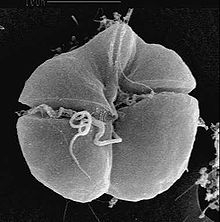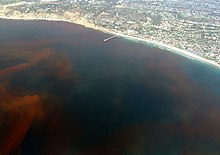

Neurotoxic shellfish poisoning (NSP) is caused by the consumption of brevetoxins, which are marine toxins produced by the dinoflagellate Karenia brevis (among several others). These toxins can produce a series of gastrointestinal and neurological effects. Outbreaks of NSP commonly take place following harmful algal bloom (HAB) events, commonly referred to as "Florida red tide" (given that blooms are more commonplace along the coasts of Florida and Texas, especially during late summer and early fall). Algal blooms are a naturally-occurring phenomenon, however their frequency has been increasing in recent decades at least in-part due to human activities, climate changes, and the eutrophication (over-abundance of plant nutrients as a result of agricultural runoff, deforestation, river bed erosion, etc.) of marine waters.[1][2][3][4] HABs have been occurring for all of documented history, evidenced by the Native Americans' understanding of the dangers of shellfish consumption during periods of marine bioluminescence (a phenomenon observed during algal blooms).[5] Blooms have been noted to occur as far north as North Carolina and are commonly seen alongside the widespread death of fish and sea birds.[4] In addition to the effects on human health, the economic impact of HAB-associated shellfish toxin outbreaks can have significant economic implications as well due to not only the associated healthcare costs, but the adverse impact on the commercial shellfish industry.[3]
- ^ Zhang, Fan; Xu, Xunxun; Li, Tingting; Liu, Zhonghua (2013-11-28). "Shellfish Toxins Targeting Voltage-Gated Sodium Channels". Marine Drugs. 11 (12): 4698–4723. doi:10.3390/md11124698. ISSN 1660-3397. PMC 3877881. PMID 24287955.
- ^ Yang, Xiao-e; Wu, Xiang; Hao, Hu-lin; He, Zhen-li (March 2008). "Mechanisms and assessment of water eutrophication". Journal of Zhejiang University Science B. 9 (3): 197–209. doi:10.1631/jzus.B0710626. ISSN 1673-1581. PMC 2266883. PMID 18357622.
- ^ a b Farabegoli, Federica; Blanco, Lucía; Rodríguez, Laura; Vieites, Juan; Cabado, Ana (2018-05-29). "Phycotoxins in Marine Shellfish: Origin, Occurrence and Effects on Humans". Marine Drugs. 16 (6): 188. doi:10.3390/md16060188. ISSN 1660-3397. PMC 6025170. PMID 29844286.
- ^ a b Watkins, Sharon M. (September 2008). "Neurotoxic Shellfish Poisoning" (PDF). Marine Drugs. 6 (3): 430–455. doi:10.3390/md20080021. PMC 2579735. PMID 19005578.
- ^ Munday, Rex; Reeve, John (2013-11-11). "Risk Assessment of Shellfish Toxins". Toxins. 5 (11): 2109–2137. doi:10.3390/toxins5112109. ISSN 2072-6651. PMC 3847717. PMID 24226039.